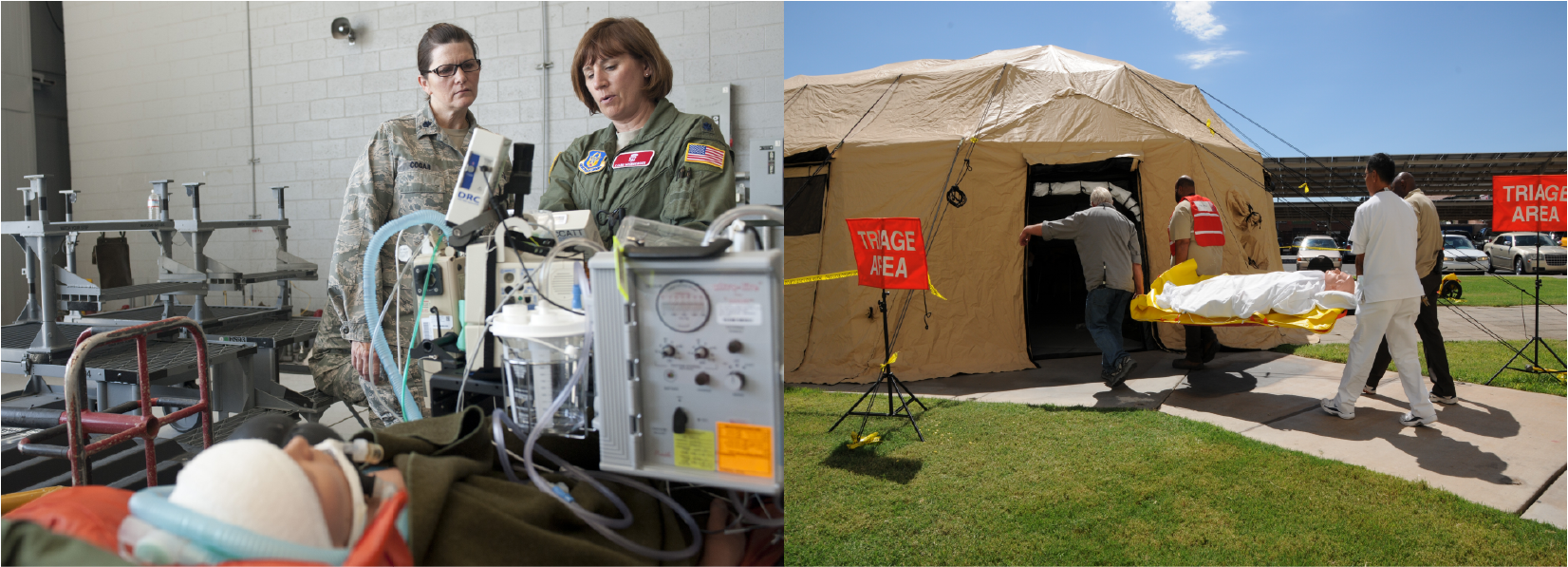Depending upon the size and severity of the incident and the robustness of local medical and veterinary infrastructure, the local or state capacity to provide appropriate care and services in the response to a chemical incident can be quickly overwhelmed. On a smaller scale, a local hospital may be overwhelmed with injured patients following a transportation HazMat accident; for example, a train derailment that released chlorine severely taxed the nearby hospital as only one physician was on duty in the emergency department.21 On a larger scale, a mass influx of patients in a short period of time, including those potentially contaminated by the chemical substance, could cripple the medical infrastructure of any large city. This happened in Tokyo following the 1995 subway sarin attack, with over 600 patients reporting to a single nearby hospital within a matter of hours, and more than 5,500 total patients reporting to hospitals city-wide over the course of the response.22
In general, first responders will treat exposed individuals for three purposes: to improve health outcomes, minimize contamination spread, and address public concerns. Due to the potential for overwhelming nearby medical facilities, responders should triage injuries and implement controls for patient flow. Initial treatment should focus on preventing further exposure, and may include decontamination steps that eliminate further exposure (such as transdermal exposure), especially when secondary exposure may be a concern (such as secondary vapor exposure), as discussed in KPF 4, Control the Spread of Contamination.
The use of staged triage, on-scene, at designated offset locations, and at nearby medical facilities, is an important strategy for maximizing the reach of limited medical resources, as well as for controlling the spread of contamination. However, in a mass casualty event, local hospitals must be prepared for patients to arrive who are not contaminated but believe they may be, particularly those who choose to “self-report” rather than being transported to a hospital in an EMS vehicle or ambulance. For example, ambulances are reported to have transported only 688 of the more than 5,500 patients seen in hospitals after the Tokyo subway attack, meaning that well over four thousand people reached hospitals by alternate means – on foot, via taxi, and private vehicles – and can be assumed to have bypassed on-scene triage stations.21,22 As discussed in KPF 4, Control the Spread of Contamination, hospitals should develop procedures for patient triage and decontamination following a chemical release.
Given the potential for a large proportion of patients to present independently to a medical facility, timely and detailed official messaging is critical for directing public movement such that any particular medical facility is not overwhelmed. To support the sustainable distribution of patients across available medical facilities, authorities need to develop clear, easy-to-understand messaging that can effectively direct patient movement and jurisdiction-wide healthcare provision strategies that can accommodate large numbers of patients.
Public concern for exposure, similarity of initial signs and symptoms to those common to stress and anxiety (racing heartbeat, dizziness, nausea), and the lack of definitive knowledge about the extent of the affected area may amplify the demand for medical and health resources. In Tokyo, doctors and nurses faced the daunting challenge of distinguishing the 1,000 truly injured from the asymptomatic, possibly exposed or minimally exposed individuals, while simultaneously trying to diagnose the cause of the mass illness and determine an appropriate treatment.22 This situation underscored the criticality of pre-planning and swift implementation of key communications strategies for a successful response (as described in KPF 3, Communicate with External Partners and the Public). Only by providing clear and concise information in the most timely manner possible to the public can the anxiety that causes otherwise healthy people to go to hospitals be allayed.
Large numbers of concerned citizens may seek medical assistance, which, if not mitigated by behavioral and medical triage, can quickly overwhelm the ability of medical facilities to assist the injured.
The activation of pre-existing mutual-aid agreements can relieve the pressure on local medical facilities by coordinating the transfer of staff, medication, and equipment from unaffected jurisdictions. Having these plans in place beforehand is critical, as again illustrated by the 1995 sarin release in Tokyo. While other nearby hospitals offered to take some of the patients from the single hospital that received 640 patients, there was no disaster plan or means for interhospital transport of patients, and first responder ambulances were unavailable. The overwhelmed hospital was forced to handle the influx of patients on its own. As a result, patients were treated in virtually every space in the hospital – in the chapel, the outpatient department, the halls, and wards – and by any available staff, no matter their medical specialty. Staff were too overwhelmed to complete even standard medical charts.22

Footnotes
21. Kirk, M. A., & Deaton, M. L. (2007). Bringing order out of chaos: effective strategies for medical response to mass chemical exposure. Emergency medicine clinics of North America, 25(2), 527–548.
22. Levy, L., Smithson, A.E. (2000). Rethinking the Lessons of Tokyo. Ataxia: The Chemical and Biological Terrorism Threat and the US Response Stimson Report 35. (pp. 71-111). Global Health Security.


